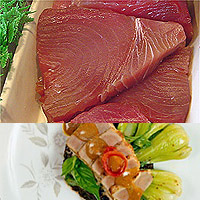Fit and Fast Recipes
Tuna

Varieties
Albacore, found in both Atlantic and Pacific waters, is the only kind that can be labeled “white meat tuna.” Bluefin, a large, oily species, is usually canned as “light meat” tuna or eaten raw. Yellowfin (called ahi in Hawaii) is the least oily kind of tuna; it is flavorful (but not strongly so) when cooked, and is good eaten raw. Bigeye is valued for sashimi. Bonito is among the smallest tuna, and has red meat. Tuna comes whole, in steaks, fillets, or loins, and fresh, frozen, or canned.
Copyright © 2025 TraceGains, Inc. All rights reserved.
Learn more about TraceGains, the company.
The information presented in the Food Guide is for informational purposes only and was created by a team of US–registered dietitians and food experts. Consult your doctor, practitioner, and/or pharmacist for any health problem and before using any supplements, making dietary changes, or before making any changes in prescribed medications. Information expires December 2025.










